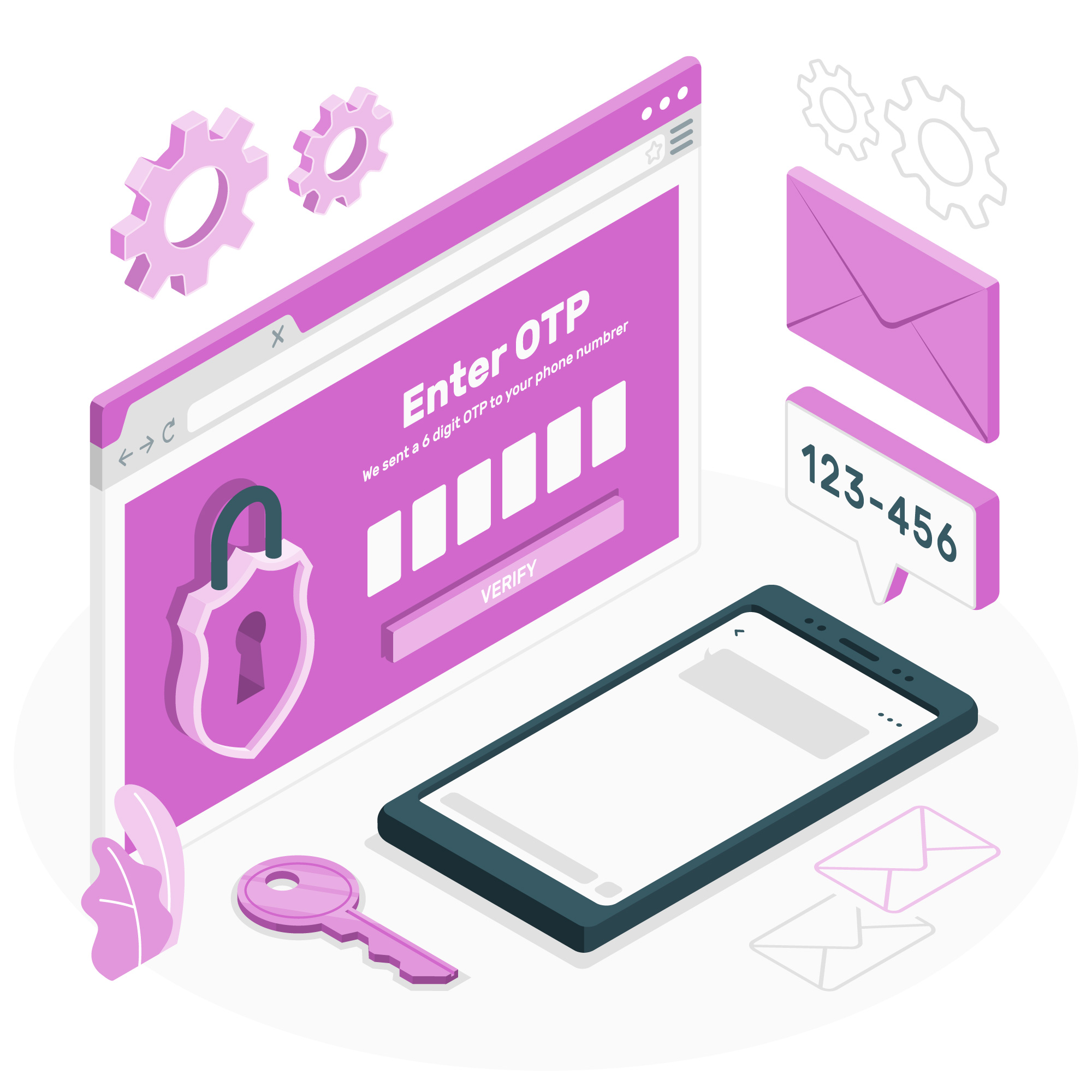Security today is more important than ever, especially as cyber threats evolve. One of the most common ways to secure user accounts is through authentication systems. Traditional methods, like passwords, are increasingly vulnerable to hacks and data breaches, making alternatives crucial.
Enter OTP (One-Time Password) APIs, essential tools for enhancing user authentication. This article will explore how OTP APIs work, their benefits, and how they integrate into your website or app to improve security and streamline user authentication.
What is one-time password (OTP) authentication?
OTP authentication requires users to verify their identity through a one-time code sent to their phone or email. Unlike traditional passwords, which are reusable, OTPs are unique, expire quickly, and provide a higher level of security.
OTPs can be used for various authentication processes, including logging into an account, confirming a transaction, or verifying changes made to an account. This makes OTPs an essential tool for modern security systems.
How OTP APIs Work
An OTP API is a service that generates and sends OTPs to users. These APIs can be integrated into websites or apps to automate the OTP generation. When a user attempts to log in or perform a sensitive action, the OTP API generates a secure, time-sensitive code and sends it to the user via SMS, email, or an authentication app.
Once the user enters the OTP, the API validates it to ensure the user is authorized. The user gains access if the OTP is correct and within the validity period. If not, access is denied, and the user is prompted to try again.
Benefits of using OTP APIs for authentication
The benefits of using OTP APIs for authentication include:
- Improved security: OTPs are critical to multi-factor authentication (MFA), significantly reducing the risk of unauthorized access. Since each OTP is unique and expires quickly, even if someone intercepts or steals a code, it’s almost impossible to use it after it expires.
- Better user experience: OTP authentication is quick and easy for users. They do not need to remember complicated passwords or worry about compromised credentials.
- Cost-effective and easy to implement: Integrating OTP APIs into your website or app is simple. Many third-party OTP API providers offer affordable services, making it a cost-effective security solution for businesses of all sizes.
How to implement OTP APIs
To integrate an OTP API, follow these simple steps:
- Choose an OTP API Provider: Popular options include Arkesel, Twilio, Authy, and Nexmo. Compare their features, pricing, and delivery methods to find the best fit for your needs.
- Integrating the API into your platform: Most providers offer detailed documentation and Software Development Kits (SDKs) to ensure a seamless and secure integration process. This integration ensures that OTPs are generated and sent automatically when users attempt to log in or perform sensitive actions, thereby improving security in real-time.
- Customize your OTP settings: You can configure OTP expiration times delivery methods (SMS, email, or authentication apps) and retry attempts to tailor the system to your platform’s needs.
- Test the OTP system: Ensure the API works as expected by testing different scenarios (e.g., OTP generation, delivery, and validation). This testing phase helps identify potential issues before deployment.
Best practices for OTP authentication
To ensure your OTP system is secure and effective, consider these best practices:
- Set expiry times: To prevent unauthorized use, OTPs should expire quickly, typically within a few minutes. This limits the window of opportunity for attackers, ensuring that even if an OTP is intercepted, it cannot be used later.
- Use multiple delivery methods: Users can receive OTPs via SMS, email, or an authentication app. Offering multiple methods increases reliability and ensures that the OTP reaches the user, even if one method fails.
- Implement rate limiting: To prevent brute-force attacks, limit the number of OTP requests a user can make quickly. This reduces the risk of attackers trying to guess the OTP.
- Encrypt OTPs: Always encrypt OTPs during transmission to protect them from being intercepted. Using HTTPS or other encryption methods ensures the security of OTPs while in transit.
- Educate users: Inform users about the importance of keeping OTPs secure. Encourage them to avoid sharing OTPs and to be cautious when entering them on unfamiliar websites or apps.
- Monitor OTP usage: Regularly monitor and log OTP usage to detect unusual or suspicious activity. This helps identify potential security breaches early.
- Update OTP technology: Keep your OTP generation and delivery technology up to date to ensure that it remains secure and efficient. Regular updates help protect against emerging threats.
Challenges and limitations of OTP APIs
Despite their many benefits, OTP APIs come with some challenges:
- Delivery issues: OTPs sent via SMS or email can sometimes be delayed. To mitigate this, offering multiple delivery methods (e.g., email, SMS, or authentication apps) ensures users can always receive their OTPs.
- User mistakes: Users may accidentally input the wrong OTP or need to remember to enter it before it expires.
- Security risks: While OTPs provide better security than traditional passwords, they are not immune to attacks. Attackers can still exploit weaknesses in the delivery method or intercept OTPs.
Case studies: Real-life examples of OTP implementation
Many leading companies have successfully implemented OTP APIs to secure their platforms. For instance, banking apps use OTPs to authorize transactions, preventing unauthorized withdrawals. Similarly, social media platforms use OTPs to secure user accounts from phishing attacks and unauthorized logins. By implementing OTP APIs, these companies have strengthened their security and enhanced user trust.
Banking and financial services
OTP SMS is used by banks to secure online transactions and login attempts, ensuring that even if passwords are compromised, unauthorized access is prevented. Enhanced security through two-factor authentication (2FA), reducing fraud and unauthorized transactions while increasing user trust in the bank’s digital platforms.
E-commerce
E-commerce platforms employ OTP SMS to authenticate customers during account creation and payment processing. This reduces fraudulent transactions and chargebacks, provides customers with a secure shopping environment, and boosts customer confidence.
Healthcare
Healthcare providers utilize OTP SMS to secure patient portals and verify identities during telemedicine appointments. Improved protection of sensitive medical data and compliance with regulatory standards (such as HIPAA), fostering patient trust and securing online health services.
Telecommunications
Telecom companies implement OTP SMS to verify customer identities during SIM activations, service changes, and number portability requests. OTPs decrease fraud, such as SIM swap scams, and improve customer security, increasing customer satisfaction and trust in telecom services.
Fintech and digital wallets
Fintech companies integrate OTP SMS to secure transactions and verify account details when users make payments or link new bank accounts. Prevention of unauthorized access and fraud, ensuring the safety of financial transactions, and increasing user confidence in digital wallets.
Strengthening security with OTP APIs
Enhancing user authentication security with OTP APIs keeps user accounts and sensitive information safe. By implementing OTPs, businesses can significantly reduce the risks associated with traditional password-based systems and foster a more secure user environment. The benefits of OTP APIs are improved security, a seamless user experience, and cost-effective implementation, making them an excellent choice for companies across industries.
Following best practices and selecting a reliable OTP provider can ensure a smooth and secure implementation despite challenges like delivery delays or user errors. Ultimately, OTP APIs help businesses build trust and protect sensitive data while enhancing overall security.





